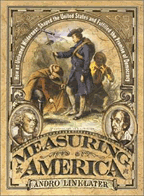| |
| |
|||
| Posted on Sun, Nov. 24, 2002 | |||

The surveyor's chain and America Measuring America For those confused about the difference between a "fifth" and "three-quarters of a liter" of Scotch, imagine purchasing libations in 18th-century America. After all, a Boston brewer's hogshead of beer, with two cooms, four kilderkins, eight rundlets, or 64 gallons, differed in size from a Pennsylvania hogshead, which in turn changed depending on whether beer was sold inside or outside an inn. In Andro Linklater's remarkable Measuring America, attempts to standardize measurement units provide the backdrop to the development of the early American republic. Weaving a history of eccentric surveyors with Jeffersonian philosophy, Linklater suggests that America's democracy resulted from the interplay of Enlightenment ideals, land speculation and utilitarian geometry. In a case of measurement driving manifest destiny, the division of the United States into sellable parcels of land first required standardized units for land areas. The size of an acre was widely accepted as a result of the surveyor's chain, a 22-yard metal chain invented by Welshman Edmund Gunter in 1607. With this chain length, a plot 10 chains long by one chain wide equaled one acre. In the 1783 Treaty of Paris, Britain ceded 18 million acres to its former colonies. With significant war debt, the nascent U.S. government was forced to survey and sell this territory. As a member of the Confederation Congress, Thomas Jefferson was a passionate believer in land ownership as necessary for democracy. He proposed that America be surveyed and mapped as a series of squares forming a large grid. The square was practical because it was easily subdivided. It was also a symbol for Jefferson of the balance among the executive, legislative and judicial branches, and a Bill of Rights for the people. Adopting Jefferson's plan for mapping the new territory, Congress passed the Ordinance of 1785, decreeing that land be divided into 36-square-mile townships with four square miles in each township set aside for government and education. Another ordinance in 1787 stipulated how new states would be formed. Slavery was banned in the new states and citizens guaranteed trial by jury and religious freedom. After this, settlers and surveyors made their way west acquiring land by legitimate sales and inevitable scams, extending the surveyed boundaries of America to the Pacific by the 1850s. Measuring America argues that the ordinances passed by Congress in 1785 and 1787 were transformative because the democratic ideals stipulated in them guaranteed "for the first time [that] an American state was to grow up around an entirely American structure of government and an American Set of Principles." Just as measurement standards led to the nation's physical growth, these American principles are standards that allow the nation to grow democratically. Because Gunter's chain was used to measure America, the United States did not accept the metric system (developed in France in 1790). Ironically, in 1783 Jefferson proposed a new set of standards that would have given the United States the first decimal measurement system, perhaps obviating the creation of the metric system. Now the United States does not share measurement standards with the rest of the world, with potential ramifications for the growth of a global democracy. Linklater, a Scottish writer and journalist, writes that he fell in love with the shape of America, flying over "the spectacular grid of city blocks, the squared-off American Gothic farms, and the long, straight section roads that caught the imagination of Kerouac." Measuring America gives the reader a new appreciation for the views out of an airplane window, and a reason to marvel at how our young country could have achieved such a coherent plan on a continental scale. Richard Di Dio teaches mathematics and physics at La Salle University. |
|||